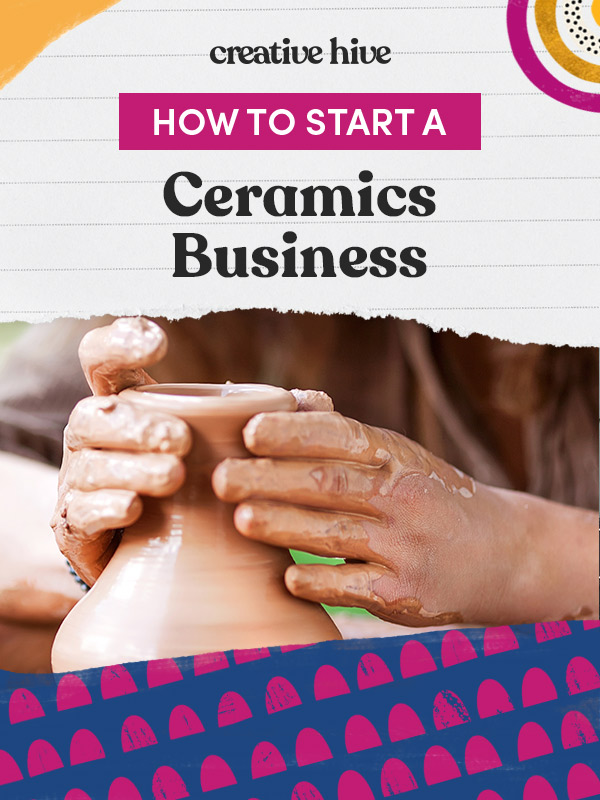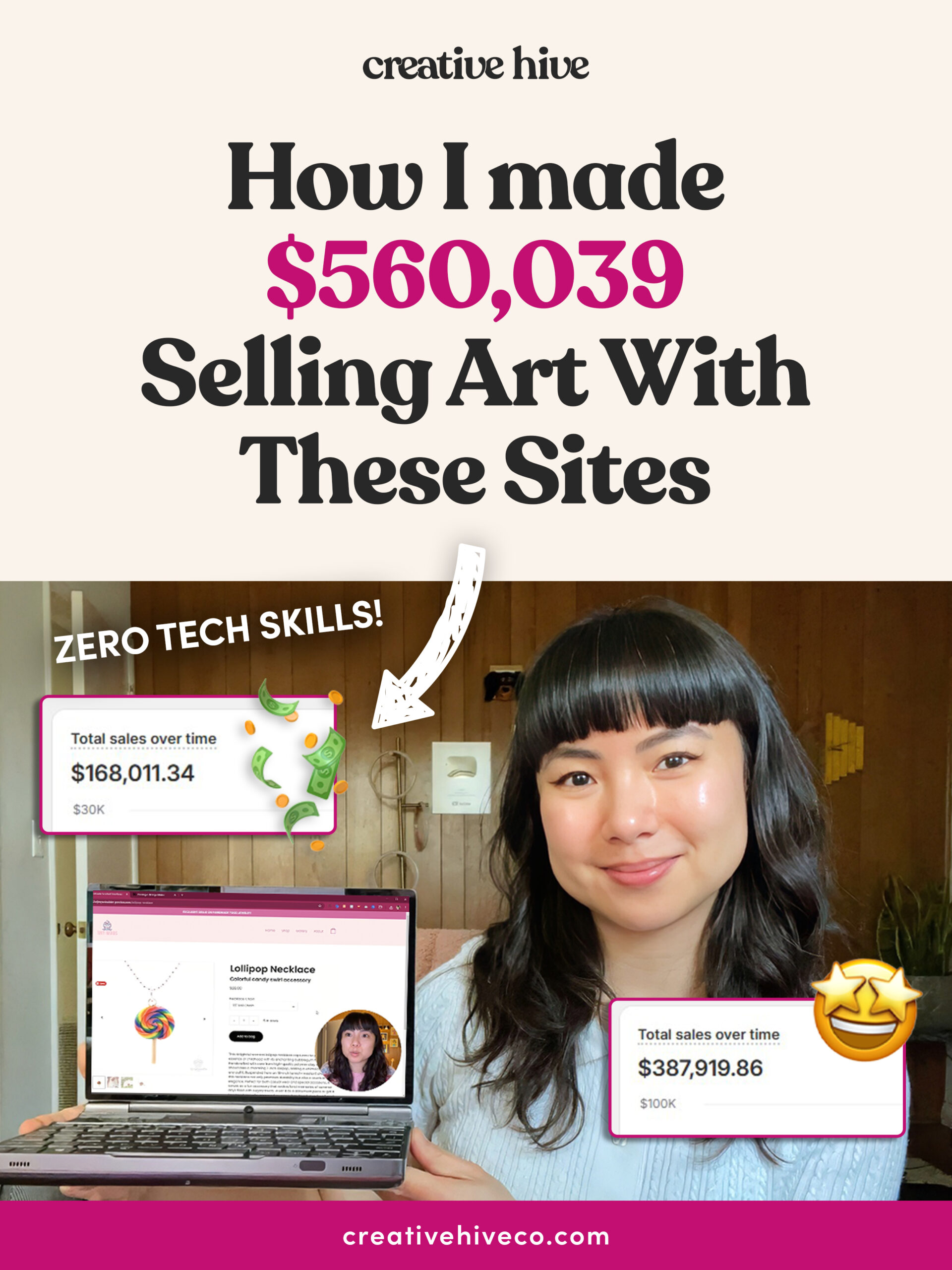I want to help you build a sustainable, profitable handmade business that makes you consistent income and sales. I only ever teach or recommend marketing, social media, pricing, production and branding tips that I’ve personally used successfully in my own 7-figure handmade businesses.
I'm Mei, from Los Angeles!
Read More
Popular Posts You'll Love
Looking for something?
Categories
starting a business
get more traffic
running a business
make more sales
branding
growing a business
mindset & productivity
podcasts
pricing & money
product photography
reviews
selling on etsy
selling on amazon
social media
selling wholesale
- Facebook0
- Twitter2
- Pinterest448
- 450shares
If you want to start selling your handmade ceramics then read this post first!
Today I’m sharing how to price your products, different challenges you might face, shipping tips, and more.
Advantages
I’m assuming that if you’re reading this post, then you’re already fairly skilled at making ceramics, whether that’s with throwing, hand-sculpting or your chosen technique.
That’s a skill that many people don’t have, so you’re already in a good position to make beautiful items that others can’t make for themselves.
So Many Options
Pottery is a broad category with so many different options. You can create almost anything from everyday items like mugs or salad bowls to expensive art pieces.
You can make things like:
- Jewelry
- Plant Pots
- Yarn Bowls
The options are endless!
Of course, you’ll be driven by your particular set of skills and passions, but just know that there is a lot of room for flexibility in this business, which is a great thing to have.
The Price Point
Unless art pieces are your specialty, you’ll most likely be pricing your items at a relatively affordable price point.
Depending on your items, you’ll likely be under the $150-mark, which means that your items are more accessible to a pretty large audience. This is a great place to be for your business.
Challenges
With that being said, there are a number of challenges that you need to look out for.
Shipping
Ceramics are fragile and, except in the case of jewelry, quite heavy. Both of these factors mean that it’s difficult and expensive to ship.
You’ll want to take extra care in your packaging to make sure your customers receive their product in one piece.
Operation Cost
There is a significant cost to operating.
You may decide to purchase your own kiln, which requires an up-front cost. You may choose to rent kiln space, which would be a recurring monthly cost.
Then you have the cost of owning or renting a wheel.
No matter how you slice it, making ceramics requires overhead that you’ll need to factor into your business.
Competition
While pottery isn’t as crowded of a market as some others, it is still pretty competitive. So, helping your business stand out from the others is crucial to success.
Products
You absolutely need to be selling designs that people actually want to buy.
The mistake I see a lot of beginning business owners make is making products that they, as the artist, love making. Unfortunately sometimes that’s not always what will sell the best.
You’re likely already drawn to one type of product over another based on your own interests and skills. Use that intuition as a starting point.
If you love crafting one-of-a-kind vases, you’d be bored out of your mind making hundreds of identical mugs every week.
Once you have a few product ideas, you want to think about what they share in common so that your shop has a cohesive common thread running through all the products that appeal to a specific group of people.
This is called a niche!
For example, you could create anything from:
- Tableware done with raku glaze
- Whimsical mugs that feature cute little animals
- Jewelry with delicately sculpted flowers
- Or super modern geometric porcelain vases
Just make sure that what you’re offering is something people want!
While it’s important to niche-down, it’s also important to consider what range you can offer so that you’re maximizing sales as well as your studio time.
If you primarily create high-end decorative vases, you may find that there isn’t a high demand, but each one sells for a nice amount of money.
If you can translate that aesthetic into small-scale jewelry pieces, you may be able to create a product that sells readily in your shop and allows you to fill the kiln with regular firings.
Popular Products
I’m going to tell you my foolproof method for figuring out what types of products are popular: spy on your competition!
This is as simple as searching on Etsy and to see what’s popular right now!
No, we’re not going to copy what other people are doing. The whole point here is to do research and see what’s trending.
Ideally, you’d stay away from a niche that’s completely flooded with low-cost competitors, because you don’t want to be drawn into competing on price.
If your passion is making a readily-available product like mugs, then it’s up to you to distinguish your product so you can charge a higher price and so people will be willing to pay more for it.
Product Uniqueness
So you’ve narrowed down your product ideas to items that you are able to make and that people will want. Now, it’s time to distinguish what makes your products unique.
In my handmade business, Tiny Hands, one way I distinguish myself is with the scents that I add to my charms. Scents are something that most shops don’t use and they make my products stand out.
You want to think about what the one thing is that makes your product stand out.
Is it:
- The artistry in the thrown piece itself?
- Your special glazing technique?
- The matching sets you create that coordinate with home decor?
Whatever it is, you want someone to see your products and know that it came from your shop.
One way to make this easy on the customer is by using a stamp that leaves an imprint on the bottom of your pieces. This is really important for branding reasons!
People may give your item as a gift without including packaging information. You want people to know where the piece came from so they can come back and purchase more from you in the future.
Pricing
There are three things you need to think about when it comes to pricing:
- How much can you earn per hour?
- How much can you earn per week?
- How much will the market bear?
How Much You Can Earn Per Hour?
You’ll want to have a look at my pricing guide, which walks you step by step through how you should be pricing your products so you’re earning a solid hourly wage.
You’ll see that in this post, I reference the ‘item cost’. It’s important to note that for pottery, this isn’t just your clay and glaze. Your cost also includes your firing cost, whether that’s the cost of your cone or the cost of you renting space in someone else’s kiln.
This is an important place to run numbers if you’re undecided on your setup.
Having your own, fully-equipped studio at home costs more upfront, but your ongoing overhead will be lower.
That’s something you’ll need to think on to decide what’s best for you and your shop.
How Much You Can Earn Per Week?
Let’s say that you’ve calculated that you can earn $20 per hour and you’re happy with that. Now you have to think of your week as a whole.
Can you really throw 8 hours a day for 5 days a week? Maybe you can, but if you’re like many of us, you’d have a really sore back.
When are you going to do your other business stuff?
It’s important to think about how many hours you can practically throw or sculpt to produce your products and decide if that’s suitable for your life.
How Much the Market Can Bear?
That is, will people buy your products at the price you need to sell it to make a living?
Be sure you’ve done your research or experimented in your own shop. You don’t want to find out later that you won’t be able to sell your bowls for the money you need to make it worth it.
If that’s the case it might be time to go back to the drawing board and brainstorm new product options.
Production Schedule
I want you to spend some time thinking about your kiln space and production schedule.
If you create super-intricate vases and can only complete one per week, you’ll get to the end of the month with only 4 pieces. That won’t even fill half the kiln!
If you have customers waiting on delivery, you’ll either be forced to keep them waiting or run a nearly-empty kiln, which risks uneven heat distribution.
Your production schedule is worth keeping in mind as you develop your product ideas, and this is where having a mix of products can help even things out.
Supplies
If you’re an experienced potter, you probably already have a source for your clay and you likely have some of your equipment as well, so I won’t go into too many details here.
Buy Wholesale
Just in case you haven’t gotten started, I’m just going to say that if you’re running a production business, you shouldn’t be buying your supplies retail!
When you purchase an item from a retail store, did you know that the shop takes about half of the cost of the product? That’s right!
The wholesale price on many items is about 50% of the retail price.
If you are purchasing significant quantities of any product, you should be able to purchase it wholesale, or at least at a discount from retail.
Many sources, like Sheffield Pottery offer quantity discounts where the more you buy, the more you save.
There’s always a balance when it comes to buying supplies. You want to buy enough to get a nice discount and save on shipping, but not so much that you’ve tied up all your money in materials that will end up sitting for a year.
Only you can calculate what’s best for your business.
Keep in mind, you’ll also need additional supplies to support the business side of things.
Shipping Materials
Shipping materials can be an extremely important business supply.
Pottery can easily break in transit, so packaging your pieces is incredibly important!
Here are a few of my recommendations when it comes to shipping materials.
They produce high-quality boxes that work great for shipping. These boxes are available in a wide range of sizes, so you can find one perfect for your pieces. You’ll also find other packaging materials. They’re not the cheapest, but they are reliable and very professional.
I’ve also shopped at ValueMailers.com and I’ve never had problems with them. They also have great prices.
They have lovely boxes and packaging that may suit your needs, depending on your product.
Your Website
Once you have your pottery business launched, you’ll want to set up your own website where you’ll be selling your work.
I talk about why your own website is better than Etsy in this video here if you want to check that out.
You’re also going to need a great collection of photos of your pieces.
It’s great to get what are called ‘lifestyle photos’, which are your items in real life situations.
Different people have different ideas about what size ‘mug’ is. They can range from holding a shot of espresso to holding 24 ounces of tea!
It’s incredibly important that you convey the size of your products in your images.
Logo
If you’re struggling with coming up with a logo, head to somewhere like Creative Market or Fivrr. There you can find a good looking template to use or find an artist who can make you a logo.
I talk all about it in my video on getting a logo done on Fiverr. You can watch if you’re interested in learning more about that.
You can also use these resources for creating your tags and print materials. A template goes a long way, so you don’t have to do everything from scratch every time!
Marketing
Once your business is open, it’s time to promote it.
You’ll want to start gathering emails for an email list, right away. You can easily use MailerLite to host a list of up to a thousand subscribers for free.
An email list has one of the highest conversion rates of any marketing, which basically means you’ll get more sales per email than you would, say, a social media post. It’s also one of the only marketing avenues that you actually own.
Facebook could shut down tomorrow (or change the algorithm) and the next thing you know, all of your fans are no longer seeing your posts.
So start an email list and put a sign up box on your site even if you aren’t actively sending emails yet.
I also recommend you reach out to anyone who has a large audience of your ideal customers and ask them to promote your products for you!
These could be social media influencers, bloggers, website editors or magazines. They’re always looking for products to feature as content to show their audience.
You can watch this video here for a step by step guide on how to do that.
I hope you’ve enjoyed those tips on starting a pottery business.
If you enjoyed this post or have any questions, leave a comment below. Don’t forget to check out my YouTube channel for more tips and inside secrets!

Leave a Comment
Liked this article? Share it!
Unlock a Profitable Handmade Business
in Just 12 Weeks Without Using Etsy
or Social Media
FREE WORKSHOP
This workshop is for anyone who makes and sells a handmade or physical product, including jewelry designers, artists, paper designers, bath & body product makers and more!
What You'll Discover
The #1 mistake people make with Etsy & social media that causes shops to FLOP
The secret to making it with your handmade shop so it's no longer just a hobby
How to make sales in your handmade shop with ease so you can finally get to 6-figures
TAKE ME THERE
Leave a Reply Cancel reply
About
Blog
A Sale A Day
Student Login
Free Class
Contact
Terms
Become A Student
Watch On YouTube
Student Reviews
See My Handmade Shop!




Your email address will not be published. Required fields are marked *